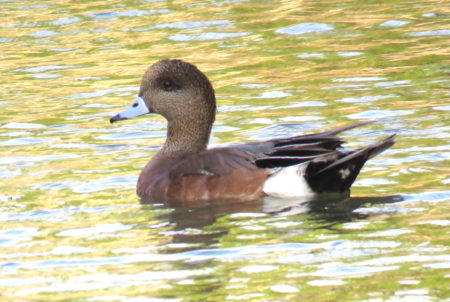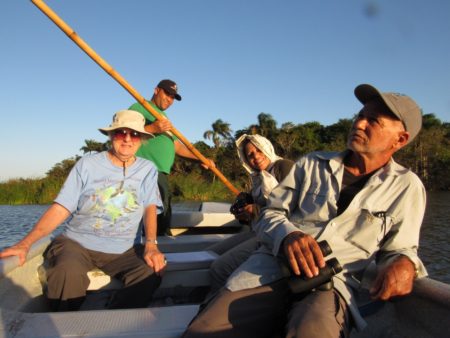We are impressed. We are excited. We are hopeful. Yes, CWC 2019 has sparked some emotions among us all!
First and foremost, we at BirdsCaribbean wish to thank you – our partners, who joined in the 2019 Caribbean Waterbird Census (CWC). The Census is now in its tenth year of data collection by energetic birders across the region. Over the three-week count period ending on February 3rd, we received a total of 321 checklists from 19 countries, with 212 different species observed. We are deeply impressed by the work you have all put in!
This year’s CWC was unusual in some ways. We were not sure what to expect. In 2017, Hurricanes Irma and Maria cut a swathe of chaos and destruction across parts of the region. Our birds suffered and struggled to survive, and conservationists struggled to recover along with them. Results from the CWC in 2018 a few months later were worrying. Our counters reported dramatic declines in the diversity and numbers, even of some of our most common bird species. We might have expected this as the hurricanes damaged fragile wetland habitats – which had already been threatened in recent years by human activities. Even though the storms occurred in 2017, those ecosystems still have a long road to recovery.
The results from this year were heartening, compared to the post-hurricane CWC results in 2018. There were quite a few surprises and records during the counts.
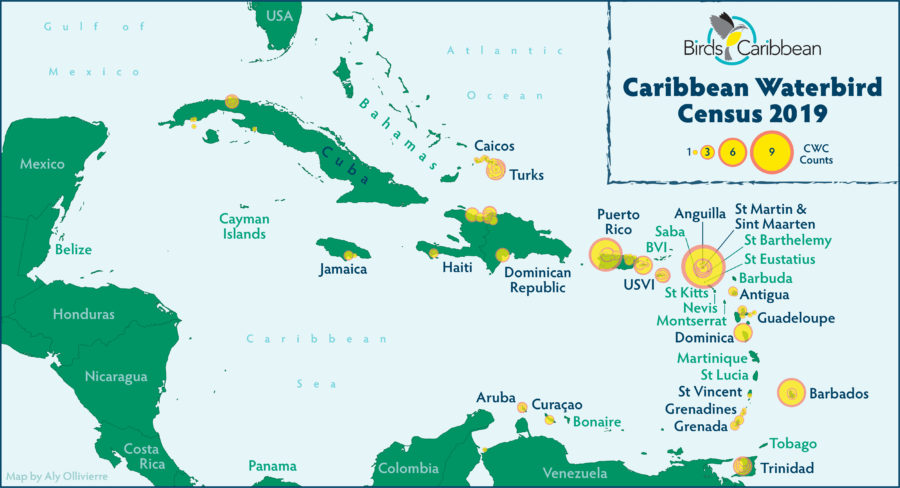
Encouraging Numbers
It’s early days yet. We won’t have a complete picture of how birds are recovering until we analyze all of the data. However, there have been promising reports from the field. In the Turks and Caicos Islands, the Canadian Wildlife Service led Piping Plover surveys with a team of partners and volunteers. The team counted 134 Piping Plovers this year at six sites – compared to 62 plovers at three sites in 2018. Among these birds, the surveyors spotted 15 marked with unique leg codes (including ten from their own study!).
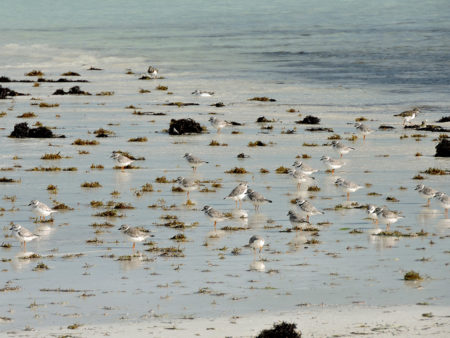
The teams visited a variety of good shorebird sites including foraging sand and mud flats, salinas, and ponds. Black Rock, an area of islets and sandbar on the south side of Middle Caicos, came out top in terms of the range of species and numbers counted. Almost 1,500 shorebirds were spotted, including 180 Red Knot (five of which were banded with unique codes). In the past, this location has yielded many bird sightings, but in the post-hurricane count last year numbers were lower (around 500 birds). This may have been due to the redistribution of sand from Hurricane Irma which limited good foraging habitat. The abundance of birds has since tripled – which is exciting news.
In Cuba, Professor Lourdes Mugica and her team from the University of Havana counted 41 Piping Plovers in Cayo Paredon Grande on the north coast of the island. Lourdes reports that they observed more Piping Plovers in other areas. However, interestingly this is the largest flock her team has ever encountered in four years of CWC monitoring. Five of the birds were banded – these were read and reported in their eBird entry.
Is it too early to suggest that this lovable, endlessly fascinating bird is making a comeback?
Exciting Discoveries
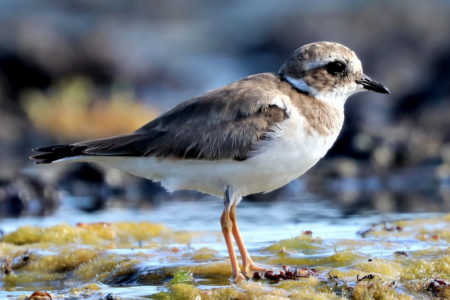
On to Antigua, where Andrea Otto and her team from the Environmental Awareness Group (EAG) spotted a Wattled Jacana! Not only is this a new island record, but it is a first sighting for the West Indies. This range map from eBird Caribbean clearly shows that this is a South American species. In addition to the jacana, the group also saw an American White Pelican – a new record for the island. Both are incredible sightings – check out the eBird report here!
Andrea and Natalya Lawrence shared the news of the Wattled Jacana sighting, explaining the importance of the CWC and Antigua’s waterbirds in a lively television interview on the “Antigua Barbuda Today” morning show. To see the interview, complete with photos, advance to 2:05:15 here). Our partners at EAG really helped to put their island’s waterbirds on the map!
Nature Explorers Anguilla also had an unexpected American White Pelican during their CWC count at Meads Bay Pond in Anguilla. According to the literature available and eBird records, it would appear to be a first record for the island. Way to go team! Their eBird list is available here.
Anthony Levesque in Guadeloupe spotted a Common Ringed Plover. This is only the 2nd Guadeloupe and 3rd Caribbean record of this species! Common Ringed Plovers usually overwinter in Africa (see the eBird range map). They are quite a challenge to identify in the field, especially when they are supposed to be on the other side of the world! Read Anthony’s descriptive notes on his eBird list here.
In Saint Vincent and the Grenadines, Lystra Culzac spotted a single male American Wigeon. This is also a rare, and possibly first, sighting for the island.
Future CWC Surveyors in the Making
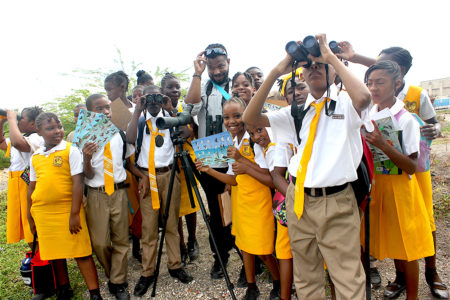
In Jamaica, the National Environment and Planning Agency (NEPA) hosted 65 students to participate in the CWC in the Palisadoes, Port Royal Protected Area. Students learned about the importance of the area, which is a RAMSAR site close to the capital city of Kingston, and the species they might encounter. In addition, they learned about the impact of pollution on this fragile environment.
The students used materials from BirdsCaribbean, including “Wetland Birds of the Caribbean” and “Seabirds of the Caribbean,” identification cards, binoculars, and data sheets, and set out to record their observations. They worked in groups of four, validating the type of birds seen under the guidance of NEPA staff. The students were excited to see the Belted Kingfisher, Magnificent Frigatebird, Royal Tern, Ruddy Turnstone, and Sandwich Tern.
On World Wetlands Day, a group from BirdLife Jamaica counted in the same area, which is slated for tourism development – including a retractable pier for cruise ships that is already on the island. How will this affect the wetland habitat and the birds that shelter there? Time will tell. Among the species counted there was a “party boat” full of Laughing Gulls.
Disturbing Events
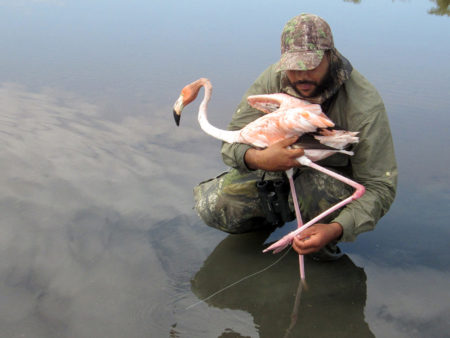
Wetlands were the focus for Maria Paulino and her team from Grupo Acción Ecológica in the Dominican Republic. However, there were some unhappy discoveries. At one of the country’s important wetland sites, Monte Cristi on the north coast, the team found large traps designed to catch American Flamingos. Tragically, other species were casualties – including a dead Snowy Egret, a dead Reddish Egret – and two days later, a similar trap was found with three dead Tricolored Herons. The team freed one trapped flamingo from a trap.
Altogether, the team removed over 300 traps! This terrible situation was reported to the Environmental Department in Santo Domingo and (hopefully) this will pressure the government into taking some action. It is not clear what the fate of the flamingos would be when caught, but Maria Paulino has heard that they are sold to resorts and hotels.
What is the CWC?
The Caribbean Waterbird Census (CWC) is a multi-partner, region-wide waterbird and wetland monitoring program led by BirdsCaribbean. The goal of this program is to learn more about the distribution, status, and abundance of waterbirds in the Caribbean in order to better conserve and manage these beautiful birds and their habitats.
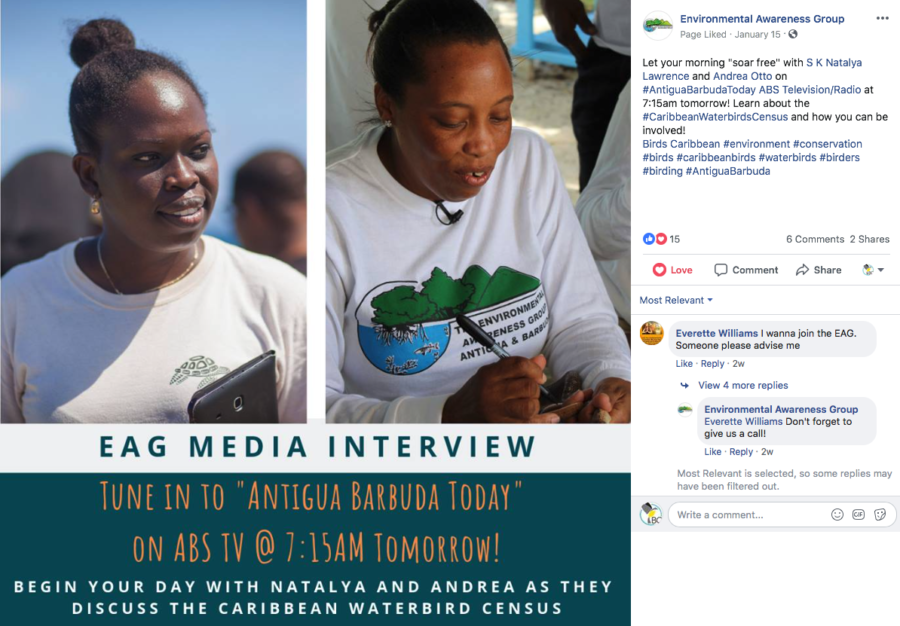
The program also aims to increase awareness, build capacity (for example through training workshops), and engage communities and volunteers in wetland monitoring and conservation. Ultimately, we want to identify and ensure that as many important wetland sites as possible are protected, thus nurturing the many fascinating bird species that live in them.
Since the program began in 2010, dedicated bird enthusiasts have ventured into wetlands across the Caribbean to systematically survey all types of waterbirds (shorebirds, seabirds, wading birds, marshbirds, and waterfowl). The three-week regional counting period begins on January 14th and ends on February 3rd each year – just including World Wetlands Day (February 2nd).
However, this is not a “once per year” event – you certainly don’t have to wait until January of 2020 to join the CWC. We collect data all year-round! To learn more about migration routes and important stopover sites, everyone is asked to count waterbirds as often as possible throughout the year, especially during migration periods in fall (August-November) and spring (March-May).
The CWC forms part of the International Waterbird Census (IWC) – the largest volunteer waterbird count in the world, organized by Wetlands International and now in its 53rd year. We are still relatively “new kids on the block,” but after ten years we are making valuable contributions to the knowledge base for these critical but often overlooked species.
The collected data is recorded on the newly designed eBird Caribbean online platform.
Any time you are counting birds in Caribbean wetlands, you can enter your data on eBird as a CWC Point Count or Traveling Count. Make sure to choose one of these protocols on “Observation Type” if using the eBird Mobile app (be sure to choose eBird Caribbean portal in your Settings), or on Step 2 of data entry on your laptop.
